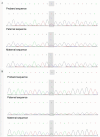Secondary hemophagocytic lymphohistiocytosis in a 5-month-old infant with IBD post-COVID-19: a case report
- PMID: 40376626
- PMCID: PMC12078334
- DOI: 10.3389/fped.2025.1536066
Secondary hemophagocytic lymphohistiocytosis in a 5-month-old infant with IBD post-COVID-19: a case report
Abstract
Background: COVID-19 is known to induce cytokine storms and inappropriate cytotoxic immune responses. Hemophagocytic lymphohistiocytosis (HLH) is an underrecognized condition due to a hyperinflammatory syndrome characterized by fulminant hypercytokinemia with a high mortality burden. Cases of severe acute respiratory syndrome coronavirus 2 (SARS-CoV-2) induced secondary HLH during and post-infection have been sparsely reported in children. Inflammatory bowel disease (IBD) is a chronic, relapsing disorder of the gastrointestinal tract with a multifactorial etiology involving genetic, environmental, and immunological factors. To date, secondary HLH associated with COVID-19 in very early-onset inflammatory bowel disease (VEO-IBD) has not been reported. This case report aims to enhance understanding of the clinical manifestations of VEO-IBD and HLH, thereby facilitating the timely diagnosis and management of this rare condition.
Case presentation: We present the case of a 5-month-old Chinese female infant diagnosed with HLH following COVID-19 infection. The patient presented with hemophagocytic syndrome, which included recurrent fever, hepatosplenomegaly, cytopenia, hyperferritinemia, hypertriglyceridemia, and hypofibrinogenemia, after exposure to her mother, who had been diagnosed with COVID-19. Whole-exome sequencing(WES) identified heterozygous mutations in the IL-10RA gene: c.537 G > A (inherited from her mother) and c.301 C > T (inherited from her father), who was ultimately identified as having VEO-IBD. Despite receiving nutritional support, intravenous immunoglobulin (IVIG), and dexamethasone therapy, the patient continued to experience anemia, diarrhea, and refractory gastrointestinal bleeding. Following a brief improvement after interventional treatment, the parents declined further medical interventions, signed for discharge, and the infant sadly passed away three months later.
Conclusion: Rare genetic variants play a pivotal role in the pathogenesis of VEO-IBD, particularly in infants diagnosed before the age of one. These cases often demonstrate resistance to various immunosuppressive therapies and have a poor prognosis with conventional treatments. Our findings highlight the potential increased risk of severe HLH in patients with VEO-IBD and concurrent COVID-19, underscoring the need for comprehensive and vigilant differential diagnosis when patients exhibit symptoms suggestive of multi-organ damage.
Keywords: COVID-19; IL-10RA; child; hemophagocytic lymphohistiocytosis; inflammatory bowel diseases.
© 2025 Chen, He, Li, Qiao and Lu.
Conflict of interest statement
The authors declare that the research was conducted in the absence of any commercial or financial relationships that could be construed as a potential conflict of interest.
Figures




Similar articles
-
Familial Hemophagocytic Lymphohistiocytosis secondary to UNC13D mutation: a report of two cases.BMC Pediatr. 2022 Nov 19;22(1):667. doi: 10.1186/s12887-022-03746-9. BMC Pediatr. 2022. PMID: 36401200 Free PMC article.
-
Hemophagocytic lymphohistiocytosis: a review inspired by the COVID-19 pandemic.Rheumatol Int. 2021 Jan;41(1):7-18. doi: 10.1007/s00296-020-04636-y. Epub 2020 Jun 25. Rheumatol Int. 2021. PMID: 32588191 Free PMC article. Review.
-
TNFAIP3 mutation causing haploinsufficiency of A20 with a hemophagocytic lymphohistiocytosis phenotype: a report of two cases.Pediatr Rheumatol Online J. 2022 Sep 5;20(1):78. doi: 10.1186/s12969-022-00735-1. Pediatr Rheumatol Online J. 2022. PMID: 36064566 Free PMC article.
-
Case Report: A Novel Compound Heterozygous Mutation in IL-10RA in a Chinese Child With Very Early-Onset Inflammatory Bowel Disease.Front Pediatr. 2021 May 25;9:678390. doi: 10.3389/fped.2021.678390. eCollection 2021. Front Pediatr. 2021. PMID: 34113591 Free PMC article.
-
Familial Hemophagocytic Lymphohistiocytosis.2006 Mar 22 [updated 2024 Jun 6]. In: Adam MP, Feldman J, Mirzaa GM, Pagon RA, Wallace SE, Amemiya A, editors. GeneReviews® [Internet]. Seattle (WA): University of Washington, Seattle; 1993–2025. 2006 Mar 22 [updated 2024 Jun 6]. In: Adam MP, Feldman J, Mirzaa GM, Pagon RA, Wallace SE, Amemiya A, editors. GeneReviews® [Internet]. Seattle (WA): University of Washington, Seattle; 1993–2025. PMID: 20301617 Free Books & Documents. Review.
References
Publication types
LinkOut - more resources
Full Text Sources
Miscellaneous

